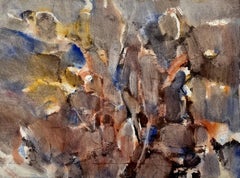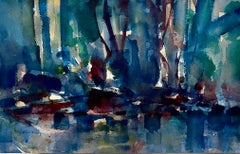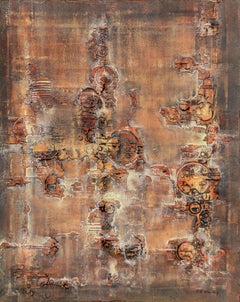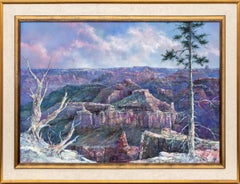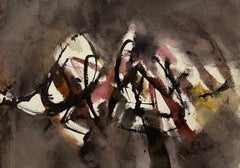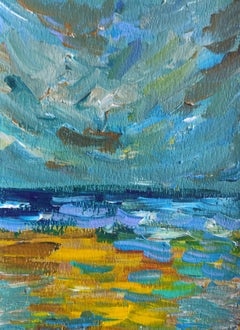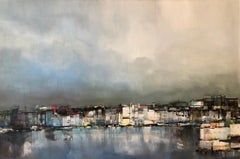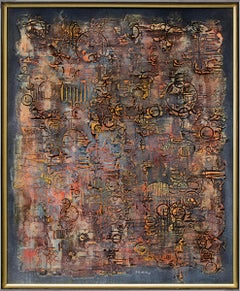Pawel Kontny Paintings
Polish, 1923-2002
A painter of subjects from many parts of the world, Pawel Kontny began with wartime sketches and changed to a technique combining abstraction and realism.
He was born in Laurahuette, Poland, the son of a wealthy pastry shop owner. He studied architecture, but was interrupted by World War II. Traveling in many countries as a soldier, he sketched various landscapes but in 1945, he was captured and held as a prisoner of war in Italy.
After the war, he studied at the Union of Nuremberg Architects to help design buildings to replace ones destroyed in the war. He also married Irmgard, a dancer with the Nuremberg Opera Company and began having well received exhibitions of his work throughout Europe.
His primary subject became architecture which he built up on heavy weight masonite panels into structures with marble dust.
In 1969, the Kotnys moved to Denver, Colorado where he began painting the American West. In February, 1974, "American Artist" magazine had a feature article by John Jellico on Pawel Kontny.to
1
3
4
1
Overall Width
to
Overall Height
to
8
1
1
4
3
1
6
2
1
1
1
1
1
1
8
5
5
5
3
12
788
694
655
572
2
2
8
Artist: Pawel Kontny
Large Modernist Abstract Expressionist Watercolor Painting Bauhaus Weimar Artist
By Pawel Kontny
Located in Surfside, FL
Abstract watercolor composition bearing the influence of the earlier color-block compositions of Paul Klee.
Pawel August Kontny, (Polish-German-American artist) He was born in Laurahuette, Poland, in 1923, the son of a wealthy pastry shop owner. In 1939 he began studying architecture in Breslau where he was introduced to the European masters and to the work of some of the German Expressionists, soon afterward banned as "degenerate artists" and removed from museums throughout Germany by the Nazi regime. His studies were interrupted by World War II. Drafted into the German army, traveling in many countries as a soldier, he sketched various landscapes but in 1945, he was captured and held as a prisoner of war in Italy. After the war, he studied at the Union of Nuremberg Architects to help design buildings to replace ones destroyed in the war. He recorded his impressions of the local population and the landscapes through his watercolors and drawings. Pawel Kontny thereafter moved to Nuremberg, Germany, becoming a member of the Union of Nuremberg Architects and helping to rebuild the city's historic center. He soon decided to concentrate on his professional art career. He married Irmgard Laurer, a dancer with the Nuremberg Opera. Pavel Kontny 's career as an artist was launched with his participation in an all German exhibition, held at the Dusseldorf Museum in 1952. He held one-man shows in Germany, Switzerland and the United States. During his trip to the United States in 1960, Kontny became instantly enamored with Colorado, and decided to relocate to Cherry Hills with his wife and two children. He quickly established himself in the local art community, being affiliated for a time with Denver Art Galleries and Saks Galleries. His subject matter became the Southwest. During this time he received the Prestigious Gold Medal of the Art Academy of Rome. His extensive travel provided material for the paintings he did using his hallmark marble dust technique. he also worked equally in pastel, watercolor, charcoal and pencil-and-ink. in a style which merged abstraction and realist styles, influenced by Abstract Expressionist painting and South Western American landscapes. In the early 1960s he was one of only a few European-born professional artists in the state, a select group that included Herbert Bayer (1900-1985), a member of the prewar Bauhaus in Weimar and Dessau, Germany, and Roland Detre (1903-2001), a Hungarian modernist painter. As a Denver, Colorado resident, Pavel Kontny exhibited at galleries and museums throughout the United States, Germany and Japan. There, he was inspired by frequent trips to Native American pueblos in the Southwest, as well as by the study of the Plains Indians of Montana and Wyoming. Over the years Kontny had a number of students and generously helped young artist by hosting exhibitions at his Cherry Hills home. For many years he generously donated his paintings to support charitable causes in Denver. Influences during his European years included German pastelist C.O. Muller, German Informel painter Karl Dahmen and Swiss artist, Hans Erni. In the early 1950s his painting style showed the influence of the Die Brücke (The Bridge), a group of German expressionist artists formed in Dresden in 1905 who had a major impact on the evolution of modern art in the twentieth century in Germany. By the middle of the decade his style incorporated more referential abstraction and total abstraction, resulting in part from his study of Hans Hartung, a German artist based in Paris who exhibited his gestural abstract work in Germany. The American moon landing in 1969 inspired Paul Kontny...
Category
Mid-20th Century Abstract Expressionist Pawel Kontny Paintings
Materials
Watercolor, Archival Paper
Modernist Abstract Expressionist Watercolor Painting Bauhaus Weimar Pawel Kontny
By Pawel Kontny
Located in Surfside, FL
Abstract watercolor composition bearing the influence of the earlier color-block compositions of Paul Klee.
Pawel August Kontny, (Polish-German-American artist) He was born in Laurahuette, Poland, in 1923, the son of a wealthy pastry shop owner. In 1939 he began studying architecture in Breslau where he was introduced to the European masters and to the work of some of the German Expressionists, soon afterward banned as "degenerate artists" and removed from museums throughout Germany by the Nazi regime. His studies were interrupted by World War II. Drafted into the German army, traveling in many countries as a soldier, he sketched various landscapes but in 1945, he was captured and held as a prisoner of war in Italy. After the war, he studied at the Union of Nuremberg Architects to help design buildings to replace ones destroyed in the war. He recorded his impressions of the local population and the landscapes through his watercolors and drawings. Pawel Kontny thereafter moved to Nuremberg, Germany, becoming a member of the Union of Nuremberg Architects and helping to rebuild the city's historic center. He soon decided to concentrate on his professional art career. He married Irmgard Laurer, a dancer with the Nuremberg Opera. Pavel Kontny 's career as an artist was launched with his participation in an all German exhibition, held at the Dusseldorf Museum in 1952. He held one-man shows in Germany, Switzerland and the United States. During his trip to the United States in 1960, Kontny became instantly enamored with Colorado, and decided to relocate to Cherry Hills with his wife and two children. He quickly established himself in the local art community, being affiliated for a time with Denver Art Galleries and Saks Galleries. His subject matter became the Southwest. During this time he received the Prestigious Gold Medal of the Art Academy of Rome. His extensive travel provided material for the paintings he did using his hallmark marble dust technique. he also worked equally in pastel, watercolor, charcoal and pencil-and-ink. in a style which merged abstraction and realist styles, influenced by Abstract Expressionist painting and South Western American landscapes. In the early 1960s he was one of only a few European-born professional artists in the state, a select group that included Herbert Bayer (1900-1985), a member of the prewar Bauhaus in Weimar and Dessau, Germany, and Roland Detre (1903-2001), a Hungarian modernist painter. As a Denver, Colorado resident, Pavel Kontny exhibited at galleries and museums throughout the United States, Germany and Japan. There, he was inspired by frequent trips to Native American pueblos in the Southwest, as well as by the study of the Plains Indians of Montana and Wyoming. Over the years Kontny had a number of students and generously helped young artist by hosting exhibitions at his Cherry Hills home. For many years he generously donated his paintings to support charitable causes in Denver. Influences during his European years included German pastelist C.O. Muller, German Informel painter Karl Dahmen and Swiss artist, Hans Erni. In the early 1950s his painting style showed the influence of the Die Brücke (The Bridge), a group of German expressionist artists formed in Dresden in 1905 who had a major impact on the evolution of modern art in the twentieth century in Germany. By the middle of the decade his style incorporated more referential abstraction and total abstraction, resulting in part from his study of Hans Hartung, a German artist based in Paris who exhibited his gestural abstract work in Germany. The American moon landing in 1969 inspired Paul Kontny...
Category
20th Century American Modern Pawel Kontny Paintings
Materials
Canvas, Oil
Mid-Century Abstract Mixed Media 'Transfiguration' Composition with Marble Dust
By Pawel Kontny
Located in Denver, CO
"Transfiguration" is a captivating original abstract painting by the talented artist Pawel Kontny (also known as Paul Kontny), created during the mid-20th century. This unique composition was crafted using a combination of marble dust, gesso, and oil glaze on masonite, resulting in a striking raised texture that adds depth and dimension to the artwork. The use of marble dust and gesso gives the piece a rich, tactile quality, making it visually stunning.
The painting is rendered in a harmonious palette of neutral tones, including shades of brown, beige, yellow, and grey, creating a subtle yet powerful interplay of light and shadow. These muted hues evoke a sense of calm and contemplation, allowing the viewer to immerse themselves in the abstract forms and textures that dominate the canvas.
This piece is presented in its original black and gold frame, which enhances its vintage charm and complements the sophisticated color palette. "Transfiguration" is an exceptional work of art, perfect for collectors of mid-century abstract art...
Category
1960s Abstract Pawel Kontny Paintings
Materials
Marble
Grand Canyon, Arizona - Large Vintage Southwestern Landscape with Evening Clouds
By Pawel Kontny
Located in Denver, CO
This striking original painting by renowned artist Pawel (Paul) Kontny captures the grandeur of the Grand Canyon in Arizona during an evening sunset. The semi-abstract landscape feat...
Category
1980s American Impressionist Pawel Kontny Paintings
Materials
Gesso, Mixed Media, Oil
Large Modernist Abstract Expressionist Gouache Painting Bauhaus Weimar Artist
By Pawel Kontny
Located in Surfside, FL
Abstract watercolor or gouache composition bearing the influence of the earlier color-block compositions of Paul Klee.
Pawel August Kontny, (Polish-German-American artist) He was born in Laurahuette, Poland, in 1923, the son of a wealthy pastry shop owner. In 1939 he began studying architecture in Breslau where he was introduced to the European masters and to the work of some of the German Expressionists, soon afterward banned as "degenerate artists" and removed from museums throughout Germany by the Nazi regime. His studies were interrupted by World War II. Drafted into the German army, traveling in many countries as a soldier, he sketched various landscapes but in 1945, he was captured and held as a prisoner of war in Italy. After the war, he studied at the Union of Nuremberg Architects to help design buildings to replace ones destroyed in the war. He recorded his impressions of the local population and the landscapes through his watercolors and drawings. Pawel Kontny thereafter moved to Nuremberg, Germany, becoming a member of the Union of Nuremberg Architects and helping to rebuild the city's historic center. He soon decided to concentrate on his professional art career. He married Irmgard Laurer, a dancer with the Nuremberg Opera. Pavel Kontny 's career as an artist was launched with his participation in an all German exhibition, held at the Dusseldorf Museum in 1952. He held one-man shows in Germany, Switzerland and the United States. During his trip to the United States in 1960, Kontny became instantly enamored with Colorado, and decided to relocate to Cherry Hills with his wife and two children. He quickly established himself in the local art community, being affiliated for a time with Denver Art Galleries and Saks Galleries. His subject matter became the Southwest. During this time he received the Prestigious Gold Medal of the Art Academy of Rome. His extensive travel provided material for the paintings he did using his hallmark marble dust technique. he also worked equally in pastel, watercolor, charcoal and pencil-and-ink. in a style which merged abstraction and realist styles, influenced by Abstract Expressionist painting and South Western American landscapes. In the early 1960s he was one of only a few European-born professional artists in the state, a select group that included Herbert Bayer (1900-1985), a member of the prewar Bauhaus in Weimar and Dessau, Germany, and Roland Detre (1903-2001), a Hungarian modernist painter. As a Denver, Colorado resident, Pavel Kontny exhibited at galleries and museums throughout the United States, Germany and Japan. There, he was inspired by frequent trips to Native American pueblos in the Southwest, as well as by the study of the Plains Indians of Montana and Wyoming. Over the years Kontny had a number of students and generously helped young artist by hosting exhibitions at his Cherry Hills home. For many years he generously donated his paintings to support charitable causes in Denver. Influences during his European years included German pastelist C.O. Muller, German Informel painter Karl Dahmen and Swiss artist, Hans Erni. In the early 1950s his painting style showed the influence of the Die Brücke (The Bridge), a group of German expressionist artists formed in Dresden in 1905 who had a major impact on the evolution of modern art in the twentieth century in Germany. By the middle of the decade his style incorporated more referential abstraction and total abstraction, resulting in part from his study of Hans Hartung, a German artist based in Paris who exhibited his gestural abstract work in Germany. The American moon landing in 1969 inspired Paul Kontny...
Category
20th Century American Modern Pawel Kontny Paintings
Materials
Watercolor, Archival Paper
Modernist Abstract Expressionist Watercolor Painting Bauhaus Weimar Artist
By Pawel Kontny
Located in Surfside, FL
Abstract watercolor composition bearing the influence of the earlier color-block compositions of Paul Klee.
Pawel August Kontny, (Polish-German-American artist) He was born in Laurahuette, Poland, in 1923, the son of a wealthy pastry shop owner. In 1939 he began studying architecture in Breslau where he was introduced to the European masters and to the work of some of the German Expressionists, soon afterward banned as "degenerate artists" and removed from museums throughout Germany by the Nazi regime. His studies were interrupted by World War II. Drafted into the German army, traveling in many countries as a soldier, he sketched various landscapes but in 1945, he was captured and held as a prisoner of war in Italy. After the war, he studied at the Union of Nuremberg Architects to help design buildings to replace ones destroyed in the war. He recorded his impressions of the local population and the landscapes through his watercolors and drawings. Pawel Kontny thereafter moved to Nuremberg, Germany, becoming a member of the Union of Nuremberg Architects and helping to rebuild the city's historic center. He soon decided to concentrate on his professional art career. He married Irmgard Laurer, a dancer with the Nuremberg Opera. Pavel Kontny 's career as an artist was launched with his participation in an all German exhibition, held at the Dusseldorf Museum in 1952. He held one-man shows in Germany, Switzerland and the United States. During his trip to the United States in 1960, Kontny became instantly enamored with Colorado, and decided to relocate to Cherry Hills with his wife and two children. He quickly established himself in the local art community, being affiliated for a time with Denver Art Galleries and Saks Galleries. His subject matter became the Southwest. During this time he received the Prestigious Gold Medal of the Art Academy of Rome. His extensive travel provided material for the paintings he did using his hallmark marble dust technique. he also worked equally in pastel, watercolor, charcoal and pencil-and-ink. in a style which merged abstraction and realist styles, influenced by Abstract Expressionist painting and South Western American landscapes. In the early 1960s he was one of only a few European-born professional artists in the state, a select group that included Herbert Bayer (1900-1985), a member of the prewar Bauhaus in Weimar and Dessau, Germany, and Roland Detre (1903-2001), a Hungarian modernist painter. As a Denver, Colorado resident, Pavel Kontny exhibited at galleries and museums throughout the United States, Germany and Japan. There, he was inspired by frequent trips to Native American pueblos in the Southwest, as well as by the study of the Plains Indians of Montana and Wyoming. Over the years Kontny had a number of students and generously helped young artist by hosting exhibitions at his Cherry Hills home. For many years he generously donated his paintings to support charitable causes in Denver. Influences during his European years included German pastelist C.O. Muller, German Informel painter Karl Dahmen and Swiss artist, Hans Erni. In the early 1950s his painting style showed the influence of the Die Brücke (The Bridge), a group of German expressionist artists formed in Dresden in 1905 who had a major impact on the evolution of modern art in the twentieth century in Germany. By the middle of the decade his style incorporated more referential abstraction and total abstraction, resulting in part from his study of Hans Hartung, a German artist based in Paris who exhibited his gestural abstract work in Germany. His work also bears the influence of Sam Francis. The American moon landing in 1969 inspired Paul Kontny...
Category
Mid-20th Century American Modern Pawel Kontny Paintings
Materials
Watercolor, Archival Paper
Modernist Abstract Expressionist Watercolor Painting Bauhaus Weimar Pawel Kontny
By Pawel Kontny
Located in Surfside, FL
Abstract watercolor composition bearing the influence of the earlier color-block compositions of Paul Klee.
Pawel August Kontny, (Polish-German-American artist) He was born in Laurahuette, Poland, in 1923, the son of a wealthy pastry shop owner. In 1939 he began studying architecture in Breslau where he was introduced to the European masters and to the work of some of the German Expressionists, soon afterward banned as "degenerate artists" and removed from museums throughout Germany by the Nazi regime. His studies were interrupted by World War II. Drafted into the German army, traveling in many countries as a soldier, he sketched various landscapes but in 1945, he was captured and held as a prisoner of war in Italy. After the war, he studied at the Union of Nuremberg Architects to help design buildings to replace ones destroyed in the war. He recorded his impressions of the local population and the landscapes through his watercolors and drawings. Pawel Kontny thereafter moved to Nuremberg, Germany, becoming a member of the Union of Nuremberg Architects and helping to rebuild the city's historic center. He soon decided to concentrate on his professional art career. He married Irmgard Laurer, a dancer with the Nuremberg Opera. Pavel Kontny 's career as an artist was launched with his participation in an all German exhibition, held at the Dusseldorf Museum in 1952. He held one-man shows in Germany, Switzerland and the United States. During his trip to the United States in 1960, Kontny became instantly enamored with Colorado, and decided to relocate to Cherry Hills with his wife and two children. He quickly established himself in the local art community, being affiliated for a time with Denver Art Galleries and Saks Galleries. His subject matter became the Southwest. During this time he received the Prestigious Gold Medal of the Art Academy of Rome. His extensive travel provided material for the paintings he did using his hallmark marble dust technique. he also worked equally in pastel, watercolor, charcoal and pencil-and-ink. in a style which merged abstraction and realist styles, influenced by Abstract Expressionist painting and South Western American landscapes. This one is influenced by California Abstract Expressionist artist Sam Francis. In the early 1960s he was one of only a few European-born professional artists in the state, a select group that included Herbert Bayer (1900-1985), a member of the prewar Bauhaus in Weimar and Dessau, Germany, and Roland Detre (1903-2001), a Hungarian modernist painter. As a Denver, Colorado resident, Pavel Kontny exhibited at galleries and museums throughout the United States, Germany and Japan. There, he was inspired by frequent trips to Native American pueblos in the Southwest, as well as by the study of the Plains Indians of Montana and Wyoming. Over the years Kontny had a number of students and generously helped young artist by hosting exhibitions at his Cherry Hills home. For many years he generously donated his paintings to support charitable causes in Denver. Influences during his European years included German pastelist C.O. Muller, German Informel painter Karl Dahmen and Swiss artist, Hans Erni. In the early 1950s his painting style showed the influence of the Die Brücke (The Bridge), a group of German expressionist artists formed in Dresden in 1905 who had a major impact on the evolution of modern art in the twentieth century in Germany. By the middle of the decade his style incorporated more referential abstraction and total abstraction, resulting in part from his study of Hans Hartung, a German artist based in Paris who exhibited his gestural abstract work in Germany. The American moon landing in 1969 inspired Paul Kontny...
Category
20th Century Abstract Expressionist Pawel Kontny Paintings
Materials
Watercolor, Archival Paper
Modernist Abstract Expressionist Watercolor Painting Bauhaus Weimar Artist
By Pawel Kontny
Located in Surfside, FL
Abstract watercolor composition bearing the influence of the earlier color-block compositions of Paul Klee and Abstract Expressionist master Sam Francis.
Pawel August Kontny, (Polish-German-American artist) He was born in Laurahuette, Poland, in 1923, the son of a wealthy pastry shop owner. In 1939 he began studying architecture in Breslau where he was introduced to the European masters and to the work of some of the German Expressionists, soon afterward banned as "degenerate artists" and removed from museums throughout Germany by the Nazi regime. His studies were interrupted by World War II. Drafted into the German army, traveling in many countries as a soldier, he sketched various landscapes but in 1945, he was captured and held as a prisoner of war in Italy. After the war, he studied at the Union of Nuremberg Architects to help design buildings to replace ones destroyed in the war. He recorded his impressions of the local population and the landscapes through his watercolors and drawings. Pawel Kontny thereafter moved to Nuremberg, Germany, becoming a member of the Union of Nuremberg Architects and helping to rebuild the city's historic center. He soon decided to concentrate on his professional art career. He married Irmgard Laurer, a dancer with the Nuremberg Opera. Pavel Kontny 's career as an artist was launched with his participation in an all German exhibition, held at the Dusseldorf Museum in 1952. He held one-man shows in Germany, Switzerland and the United States. During his trip to the United States in 1960, Kontny became instantly enamored with Colorado, and decided to relocate to Cherry Hills with his wife and two children. He quickly established himself in the local art community, being affiliated for a time with Denver Art Galleries and Saks Galleries. His subject matter became the Southwest. During this time he received the Prestigious Gold Medal of the Art Academy of Rome. His extensive travel provided material for the paintings he did using his hallmark marble dust technique. he also worked equally in pastel, watercolor, charcoal and pencil-and-ink. in a style which merged abstraction and realist styles, influenced by Abstract Expressionist painting and South Western American landscapes. In the early 1960s he was one of only a few European-born professional artists in the state, a select group that included Herbert Bayer (1900-1985), a member of the prewar Bauhaus in Weimar and Dessau, Germany, and Roland Detre (1903-2001), a Hungarian modernist painter. As a Denver, Colorado resident, Pavel Kontny exhibited at galleries and museums throughout the United States, Germany and Japan. There, he was inspired by frequent trips to Native American pueblos in the Southwest, as well as by the study of the Plains Indians of Montana and Wyoming. Over the years Kontny had a number of students and generously helped young artist by hosting exhibitions at his Cherry Hills home. For many years he generously donated his paintings to support charitable causes in Denver. Influences during his European years included German pastelist C.O. Muller, German Informel painter Karl Dahmen and Swiss artist, Hans Erni. In the early 1950s his painting style showed the influence of the Die Brücke (The Bridge), a group of German expressionist artists formed in Dresden in 1905 who had a major impact on the evolution of modern art in the twentieth century in Germany. By the middle of the decade his style incorporated more referential abstraction and total abstraction, resulting in part from his study of Hans Hartung, a German artist based in Paris who exhibited his gestural abstract work in Germany. The American moon landing in 1969 inspired Paul Kontny...
Category
20th Century Abstract Expressionist Pawel Kontny Paintings
Materials
Watercolor, Archival Paper
Related Items
Contemporary abstract impressionist seascape seaside acrylic painting on paper
Located in VÉNISSIEUX, FR
This artwork "When the blue sky meets the blue sea" is a captivating example of abstract expressionism, where vibrant color and dynamic brushwork coalesce to evoke an emotive landsc...
Category
2010s Abstract Expressionist Pawel Kontny Paintings
Materials
Paper, Oil
Mougenot NatalyaContemporary abstract impressionist seascape seaside acrylic painting on paper, 2024
H 8.27 in W 5.91 in D 0.04 in
WPA American Scene Modernism 20th Century NYC Industrial "Cellar with Horseshoe"
By Joseph Solman
Located in New York, NY
"Cellar with Horseshoe" WPA American Scene Modernism 20th Century NYC Industrial
Joseph Solman (1909-2008) "Cellar with Horseshoe," 16 x 20 inches, oil on canvas
circa 1938, initial...
Category
1930s American Modern Pawel Kontny Paintings
Materials
Canvas, Oil
'Untitled' Abstract Geometric Wall Piece Wood/Paint/Textile Black, White, Grays
By Jean Feinberg
Located in Wellesley, MA
ADDITIONAL PHOTOS OF THIS WORK WILL BE SENT UPON REQUEST.
NOTE COLOR OF WOOD IS NOT QUITE AS YELLOW AS IIT APPEARS IN PHOTO AND IS IN KEEPING WITH OTHERS IN THIS SERIES:
Jean Fein...
Category
2010s Abstract Geometric Pawel Kontny Paintings
Materials
Gesso, Oil, Wood Panel, Muslin
Early 20th Century Mission San Juan Capistrano - Figurative Landscape
By Warren E. Rollins
Located in Soquel, CA
Stunning figurative landscape of the Mission San Juan Capistrano by Warren Eliphalet Rollins (American, 1861-1962). Presented in a giltwood frame. "Capistrano" lower right, unsigned. This is a study for a larger painting of the same scene. Image size, 14.5"H x 21"W.
For many years Warren Eliphalet Rollins was known as the "Dean of the Santa Fe art colony." He was the first artist to have a formal exhibition there; it was held in 1906 in the old Palace of the Governors. He was a close friend of Carlos Vierra, Gerald Cassidy, Kenneth Chapman, Sheldon Parsons and most of the other famous artists who assembled in the New Mexican capital during the first half of this century.
Born in Carson City, Nevada, Rollins was raised in California and attended the San Francisco School of Design where he studied under Virgil Williams. At the completion of his studies, he was awarded the Avery Gold Medal and made Assistant Director of the school. Following his marriage in 1887, he and his wife settled in San Diego, and it was during this period that Rollins became interested in the Indian as subject matter. In search of material, Rollins, his wife, and their two daughters, Ramona and Ruth, traveled through every Western state from the Mexican to the Canadian borders. While in Montana, Rollins painted a portrait of Calamity Jane...
Category
1910s American Impressionist Pawel Kontny Paintings
Materials
Canvas, Oil
Rhodes: modern Italian watercolor of abstract Greek landscape & architecture
Located in Bryn Mawr, PA
This is a minimalist watercolor painting depicting abstracted architectural features (windows & doorway) in red and blue with the landscape and ocean of Rhodes, Greece visible. The watercolor itself measures 9.5"x6.5" and is floated in a double-mat 16.5" x 13" narrow, contemporary wood (maple) frame. Signed, titled, and dated on the back of the watercolor paper.
Diego Esposito...
Category
1970s Abstract Pawel Kontny Paintings
Materials
Watercolor
H 16.5 in W 13 in D 1.5 in
Imaginary Geometric City. Second half of the 20th century
Located in Firenze, IT
Imaginary Geometric City.
Date: Second half of the 20th century
Medium: Gouache on cardboard
Dimensions: H 63 cm x W 48 cm approx.
Description: A network of soft shapes and wa...
Category
Late 20th Century Abstract Geometric Pawel Kontny Paintings
Materials
Gouache, Illustration Board, Cardboard
Abstract Work on Paper Mid-Century Modernism Greek American Gouache Drawing
By Jean Xceron
Located in New York, NY
Abstract Work on Paper Mid-Century Modernism Greek American Gouache Drawing.
A modernist artist who emigrated to America from Greece in 1904, when he was fourteen years old, Jean Xceron is described as having a reputation as an artist that has mysteriously fallen into obscurity---especially since he was reportedly quite prominent during his lifetime. However, a partial explanation of that omission is the fact that many of his papers and early records have been lost. He was a painter of biomorphic abstractions and did collages, which were influenced by Dadaism.
Xceron was active in New York City when modernism was gaining influence. Of him during this period, it was written that his artistic role was "a vital link between what is commonly termed as the first-generation (the Stieglitz group, the Synchromists, etc.) and second-generation, the American Abstract Artists, the Transcendental Painting...
Category
1940s American Modern Pawel Kontny Paintings
Materials
Paper, Gouache
Pink Lavender Modern Abstract Landscape Painting on Canvas by British Artist
By Margaret Francis
Located in Preston, GB
‘Pink Lavender’ Modern Abstract Landscape Painting on Canvas from leading British Artist.
Margaret Francis received her Degree in Fine Art from Winchester Art...
Category
2010s Abstract Expressionist Pawel Kontny Paintings
Materials
Canvas, Cotton Canvas, Acrylic, Watercolor, Mixed Media
H 31.5 in W 31.5 in D 1.78 in
Mural Study, Early 20th Century American Impressionist Painting
By Abel Warshawsky
Located in Beachwood, OH
Abel Warshawsky (American, 1883-1962)
Mural Study
Oil on board
Signed and inscribed verso
9.5 x 18 inches
15.75 x 24.25 inches, framed
Impressionist painter A.G. Warshawsky was acti...
Category
Early 20th Century American Impressionist Pawel Kontny Paintings
Materials
Oil
Mid Century Figurative Landscape -- Aptos Village Apple Shed and Market
By Jon Blanchette
Located in Soquel, CA
Charming mid century figurative landscape of Aptos Village Apple Shed and Market by listed California artist Jon Blanchette (American, 1908-1987). Aptos is just south of Santa Cruz,...
Category
1960s American Impressionist Pawel Kontny Paintings
Materials
Canvas, Oil, Cardboard
Mid Century Sierra Mountain Lake Landscape
By Lillian Jackson Heath
Located in Soquel, CA
Sweeping mid-century landscape of a lake and snow-capped mountains by Lillian Josephine Heath (American, 1864-1961). A gigantic, snow-covered mountain dominates the upper portion of the composition, rising above the rest of the landscape. In the shadow of the mountain is a valley lake, filled with snowmelt, with several smaller mountains in between.
Signed "Lillian Heath" lower left.
Displayed in a giltwood frame.
Image, 20.5"H x 28"L.
Lillian Heath was one of the Jolly Daubers at the turn of the 19th-century and as a young student, married the senior artist and instructor, Frank Heath in Santa Cruz, California. Artists Frank and Lillian [Heath] by Margaret Koch [transcribed from Santa Cruz Public Library website]….Frank L. Heath courted Lillian Dake Storey during painting trips around Santa Cruz County back in the 1890s.
Those were the years when Lillian was riding a saddle horse daily from Santa Cruz to the Powdermill where she taught school. Today [1974] the Powdermill is Paradise Park.
Frank's actual proposal of marriage was delivered at Rocky Falls, a beautiful scenic place on Carbonero Creek. There he had constructed a painting platform with a perfect view of the rushing waters, and it was there that he asked Lillian in that formal day and age, to be his bride.
Frank was nearly 40 years old at the time, and Lillian was about 32.
She had always been interested in art and had talent to a large degree. She took a year's leave of absence from teaching school to travel alone to New York where she visited relatives and stayed to study china painting and the painting of miniatures which is an art in itself.
‘When I returned from New York I enrolled in the art classes of a Santa Cruz artist who was making a name for himself,’ she once said with a smile.
The artist was Frank L. Heath, and that was the start of their romance, she told me in 1959. She accepted Frank's proposal at Rocky Falls.
At the Heath home on Third Street, Beach Hill, Frank added a wing with a large studio workroom downstairs and several bedrooms upstairs. That was his wedding gift to his bride.
‘The Studio’ had a fireplace and big bay windows that looked out over the town of Santa Cruz and back to the mountains they both loved and painted many times. Lillian painted a set of tiles for the fireplace; they showed darting swallows in the clouds above a stream where song birds perched on tulles and water lilies floated.
In 1897 Lillian and Frank were married in the First Methodist Church and they moved into the home on Beach Hill, a house she continued to live in for 64 years.
Frank's father, Lucien Heath, was the first Secretary of State of Oregon. He came to Santa Cruz from Oregon in 1866 with his wife, Jane, and sons, Frank and Henry. A daughter, Lina, had died in Michigan where the Heaths lived before crossing the plains to Oregon in 1852. [?]
In Santa Cruz Lucien Heath opened one of the early hardware stores on Pacific Avenue in partnership with John Byrne...
Category
1940s American Impressionist Pawel Kontny Paintings
Materials
Canvas, Oil
Sierra Mountain Waterfall, Vintage California Landscape w. Ornate Giltwood Frame
Located in Soquel, CA
Sierra Mountain Waterfall, Vintage California Landscape w. Ornate Giltwood Frame
Beautiful large-scale vertical landscape of a majestic waterfall in the Sierra Mountains by Califor...
Category
1960s American Impressionist Pawel Kontny Paintings
Materials
Canvas, Oil
H 41.5 in W 29.5 in D 2 in
Previously Available Items
Modernist Colorado Oil Painting Abstract Cityscape Harbor Scene Pawel Kontny
By Pawel Kontny
Located in Surfside, FL
Urban landscape of city harbor, marine scene, (North Africa?) bearing the influence of the earlier color-block compositions of Paul Klee.
Modernist Cityscape 24" x 36" sight. oil on canvas signed lower left
Pawel August Kontny, (Polish-German-American artist) He was born in Laurahuette, Poland, in 1923, the son of a wealthy pastry shop owner. In 1939 he began studying architecture in Breslau where he was introduced to the European masters and to the work of some of the German Expressionists, soon afterward banned as "degenerate artists" and removed from museums throughout Germany by the Nazi regime. His studies were interrupted by World War II. Drafted into the German army, traveling in many countries as a soldier, he sketched various landscapes but in 1945, he was captured and held as a prisoner of war in Italy. After the war, he studied at the Union of Nuremberg Architects to help design buildings to replace ones destroyed in the war. He recorded his impressions of the local population and the landscapes through his watercolors and drawings. Pawel Kontny thereafter moved to Nuremberg, Germany, becoming a member of the Union of Nuremberg Architects and helping to rebuild the city's historic center. He soon decided to concentrate on his professional art career. He married Irmgard Laurer, a dancer with the Nuremberg Opera. Pavel Kontny 's career as an artist was launched with his participation in an all German exhibition, held at the Dusseldorf Museum in 1952. He held one-man shows in Germany, Switzerland and the United States. During his trip to the United States in 1960, Kontny became instantly enamored with Colorado, and decided to relocate to Cherry Hills with his wife and two children. He quickly established himself in the local art community, being affiliated for a time with Denver Art Galleries and Saks Galleries. His subject matter became the Southwest. During this time he received the Prestigious Gold Medal of the Art Academy of Rome. His extensive travel provided material for the paintings he did using his hallmark marble dust technique. he also worked equally in pastel, watercolor, charcoal and pencil-and-ink. in a style which merged abstraction and realist styles, influenced by Abstract Expressionist painting and South Western American landscapes. In the early 1960s he was one of only a few European-born professional artists in the state, a select group that included Herbert Bayer (1900-1985), a member of the prewar Bauhaus in Weimar and Dessau, Germany, and Roland Detre...
Category
20th Century American Modern Pawel Kontny Paintings
Materials
Canvas, Oil
Oracle (Ancient Memories Series), Textured Abstract, Red, Orange, Yellow, Gray
By Pawel Kontny
Located in Denver, CO
Oracle (Ancient Memories Series), abstract painting by Pawel Kontny (1923-2002). Colors include Red, Orange, Yellow, Gray and black. Created with marble dust, gesso and oil glaze on masonite, signed lower center, titled verso. Kontny applied his marble dust technique to three non-representational series he pursued until the end of his life. This painting is from the Ancient Memories Series, synthesizing his life-long interest in the ancient cultures of Egypt, Mesopotamia and Babylon, as well as those of the Aztecs, Mayan and Incas of the Western Hemisphere. Presented in a custom vintage frame...
Category
1970s Abstract Pawel Kontny Paintings
Materials
Marble
H 31.25 in W 25 in D 1.5 in
Modernist Colorado Oil Painting Abstract Cityscape Harbor Scene Pawel Kontny
By Pawel Kontny
Located in Surfside, FL
Urban landscape of city harbor, marine scene, (North Africa?) bearing the influence of the earlier color-block compositions of Paul Klee.
Modernist Cityscape 24" x 36" sight. oil on ...
Category
20th Century American Modern Pawel Kontny Paintings
Materials
Canvas, Oil
Abstract Painting in Dark Green, Olive, Orange, Yellow, light Brown, dark brown
By Pawel Kontny
Located in Denver, CO
An abstract expressionist painting with heavy impasto by Colorado Artist, Pawel Kontny, created using a technique with a gessoed masonite panel with marble dust paste and applied oil glazes. Painted in colors of Dark Green, Olive, Orange, Yellow, light Brown, dark brown & golden brown. Presented in a custom frame, outer dimensions measure 43 x 31 inches. Image size is 36 x 24 inches.
Provenance: Private Collection Denver, Colorado
The second oldest of five children of a prosperous bakery shop-café owner, Paul Kontny began sketching and drawing Indians based on Karl May’s popular Western novels which he read as a youngster growing up in Europe. Initially designated to take over the family business, Kontny’s father finally accepted his son’s interest in art. After relocating the family to Gleiwitz in Upper Silesia (today, Gliwice, Poland) in 1936, he engaged an unemployed artist, Michael Uliga, to provide Paul some initial art instruction. In high school Kontny received additional encouragement and direction from Professor Pautsch. While still a student he was commissioned to paint a large image of St. Anthony for the family’s parish church in Gleiwitz.
In addition to formal instruction, Kontny’s father financed Paul’s trip to the Old Masters Picture...
Category
Mid-20th Century Abstract Expressionist Pawel Kontny Paintings
Materials
Oil, Board
Pawel Kontny paintings for sale on 1stDibs.
Find a wide variety of authentic Pawel Kontny paintings available for sale on 1stDibs. If you’re browsing the collection of paintings to introduce a pop of color in a neutral corner of your living room or bedroom, you can find work that includes elements of blue and other colors. You can also browse by medium to find art by Pawel Kontny in paint, archival paper, paper and more. Much of the original work by this artist or collective was created during the 20th century and is mostly associated with the modern style. Not every interior allows for large Pawel Kontny paintings, so small editions measuring 11 inches across are available. Customers who are interested in this artist might also find the work of Sara Jaskiewicz, Agata Koczan, and Jonathan Speed. Pawel Kontny paintings prices can differ depending upon medium, time period and other attributes. On 1stDibs, the price for these items starts at $1,000 and tops out at $5,500, while the average work can sell for $1,200.
